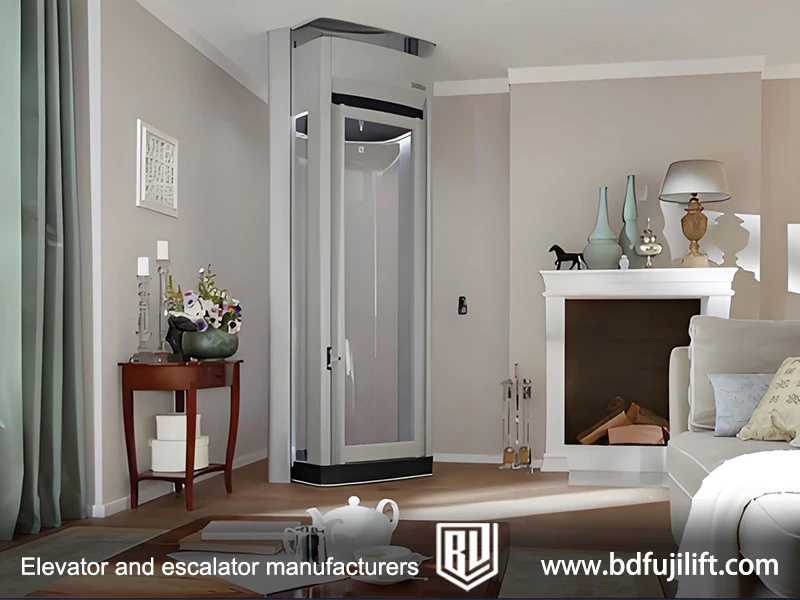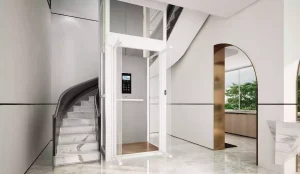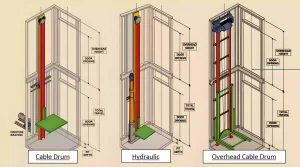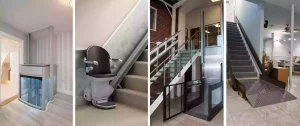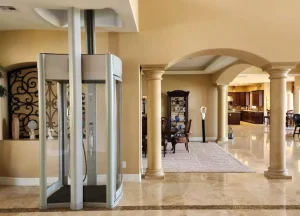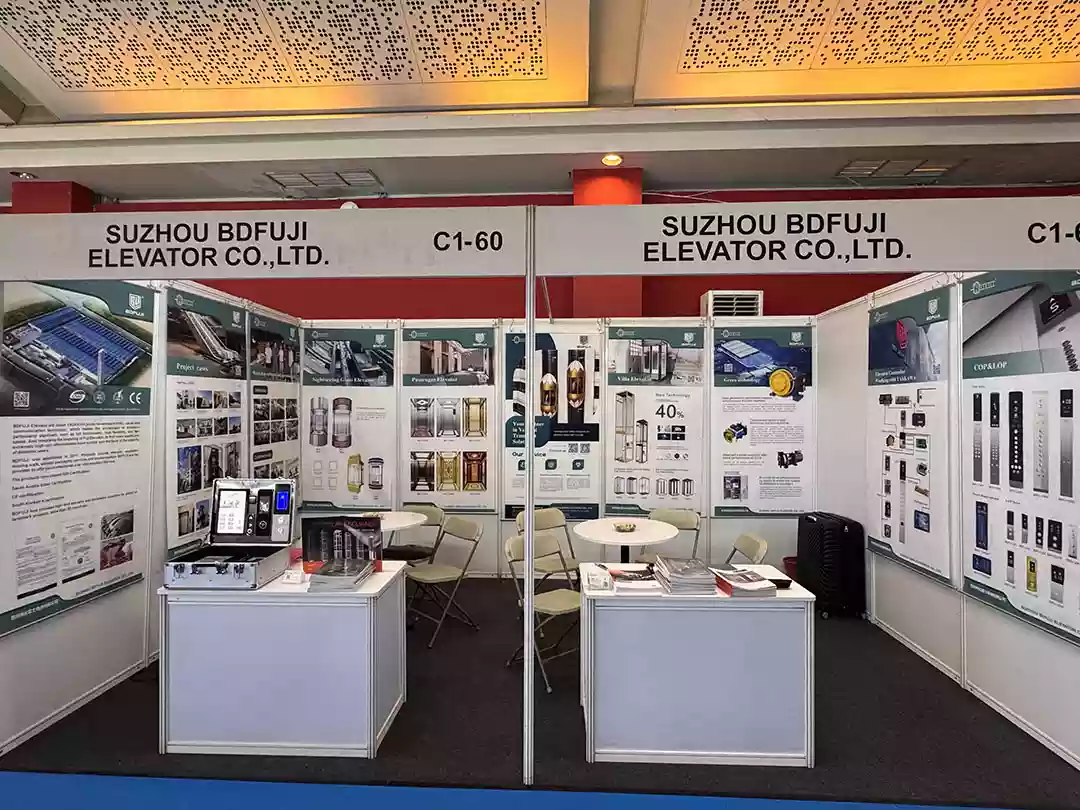Shaftless elevators are compact lift systems designed for small spaces in homes or offices. Instead of using a deep elevator shaft, they travel on a simple vertical track and are powered by a quiet motor. The elevator car is connected to the system through a small floor opening, making installation faster and less costly. This type of lift is often called a shaftless elevator or through-floor elevator.
What is a shaftless elevator?
A shaftless elevator is a type of lift that does not need a full elevator shaft. It is designed to move people or goods between two floors, often in homes or small buildings. Instead of a deep pit and tall shaft, it uses a simple guide system and a small opening in the floor. There are different kinds of shaftless elevators based on how they work, such as screw drive, hydraulic, or chain drive models. This kind of lift is also called a shaftless elevator or a through-floor lift.
How a Shaftless Elevator Works
A shaftless elevator works by moving the lift car along a guide rail between two floors. The car is powered by a drive system, such as a screw drive, hydraulic pump, or chain drive. The shaftless elevator is often installed in homes or small buildings, with the car traveling through a simple opening in the floor. The drive system moves the car up or down, and the car stops level with the floor so people can get in and out safely. This process allows the shaftless elevator to provide smooth and easy travel between levels without the need for a full elevator shaft.
Advantages of a Shaftless Elevator
- Small Space Need: A shaftless elevator takes up less room than a traditional elevator. It fits well in homes or small buildings, making it a good choice when space is limited.
- Easy Installation: Installing a shaftless elevator is simpler than building a full elevator shaft. It usually needs only a small opening in the floor, and the lift can be placed in many different spots inside the home.
- Energy Efficiency: A shaftless elevator often uses less power because it moves only between two floors. Without a large shaft and heavy equipment, it can be more efficient to run.
- Design Flexibility: The lift car can have different styles and finishes to match the home’s look. It can be open on one or more sides, and controls can be placed for easy use.
- Accessibility: A shaftless elevator makes it easier for people with limited mobility to move between floors. It can carry a wheelchair or walker, helping make the home safer and more convenient.
Disadvantages of a Shaftless Elevator
- Higher Cost: A shaftless elevator can cost more than some other types of home lifts. The price may be high for people who only need to move between two floors.
- Limited Travel Distance: Most shaftless elevators are made for short travel, usually between two levels. They are not designed for tall buildings or long distances.
- Weight Limit: A shaftless elevator may carry less weight than a full-size elevator. Heavy loads or large groups of people might need another type of lift.
- Space Changes: Installing a shaftless elevator often means cutting a hole in the floor. Some homes may also need changes to walls or nearby spaces.
Types of Shaftless Elevators
There are several types of shaftless elevators, based on how they work and how they are built.
By Drive Type
- Screw Drive Shaftless Elevators: These use a rotating screw and nut to move the lift car up and down. They are slow but steady, making them a good choice for home use.
- Hydraulic Shaftless Elevators: These use a hydraulic pump and piston to lift the car. They provide smooth movement and can carry more weight than some other types.
- Chain or Belt Drive Shaftless Elevators: These use a chain or belt system to move the car. They are compact and often need less maintenance.
By Structure
- Through-Floor Shaftless Elevators: The most common type for homes, moving between two floors through an opening in the floor above and the ceiling below. A trapdoor covers the opening when the elevator is at the lower level.
- Stair Lifts: Also called stair chairs or chair lifts, these run along the stairs and can be folded away when not in use.
- Vertical Platform Lifts: These carry a wheelchair straight up and down, usually up to about 14 feet (4.3 meters), and can be installed indoors or outdoors.
- Inclined Platform Lifts: These work like stair lifts but have a platform large enough for a wheelchair, moving at an angle along the stairs.
All shaftless elevators are built with safety in mind. They must meet building codes and be tested before use to make sure all safety devices work properly.
How Much Does a Shaftless Elevator Cost?
The cost of a shaftless elevator can vary depending on its type, size, and features. In most homes, a basic through-floor home elevator with no shaft starts at around $15,000 to $20,000. Models with more advanced drive systems, higher weight limits, or custom designs can cost $25,000 or more.
Installation costs are also part of the price. This can include cutting an opening in the floor, electrical work, and any needed changes to nearby walls. On average, installation may add $3,000 to $5,000 to the total cost.
It is important to get quotes from licensed installers in your area. They can help you choose the right shaftless elevator for your needs and make sure it meets all safety and building code requirements.
Factors That Affect the Cost of a Shaftless Elevator
- Drive Type: Screw drive models are usually the least expensive, while hydraulic and chain or belt drive models can cost more due to their parts and installation needs.
- Structure Type: Through-floor shaftless elevators are common and often cost less to install than vertical platform lifts or inclined platform lifts, which may need extra space or supports.
- Size and Capacity: Larger shaftless elevators or those with higher weight limits need stronger parts and more labor, which increases the price.
- Customization: Special finishes, unique colors, or custom car designs will add to the total cost.
- Installation Conditions: Homes that need major floor or wall changes, electrical upgrades, or extra safety features will have higher installation costs.
Why choose a shaftless home elevator?
Compared with other types of elevator used in homes, a shaftless lift offers a small footprint and space-saving layout. It reduces civil work and shortens installation time. With the right car size and door width, it can accommodate a wheelchair and keep rides safe and smooth. For many families, this residential elevator is a practical way to add comfort without major structural changes.
Where to Buy a Shaftless Elevator
A shaftless elevator can be bought from companies that sell and install home lifts. These companies can help you choose the right model for your needs and make sure it fits your home. You might want to look for a local dealer who has a showroom so you can see the elevator in person before you buy it.
Good places to look for a shaftless elevator include:
-
Home elevator companies with experience installing shaftless elevators
-
Mobility equipment stores
-
Local contractors who specialize in accessibility upgrades
-
Authorized dealers for brands that make shaftless elevators
If you decide to buy a shaftless elevator, work with an installer who knows local building codes and has a service team for maintenance and repairs.
Shaftless Elevator Installation Process
Installing a shaftless elevator usually takes less time than a full-size elevator.
- The process starts with a home visit from the installer. They check where the elevator will go and measure the space.
- Next, the team prepares the area. For a through-floor self-supporting elevator, they cut an opening in the floor between the two levels. They also make sure the floor and walls are strong enough to hold the lift.
- The elevator is then put in place, including the car, guide rails, and drive system. Electrical wiring is connected so the lift can run safely.
- Finally, the installer tests the shaftless elevator to make sure it works well and meets all safety rules. They will also show you how to use it and explain the safety features.
How to Maintain a Shaftless Elevator
Taking care of a shaftless elevator helps it run safely and last longer. Most models need only simple checks and cleaning.
Keep the area around the elevator clear so the doors and platform can move freely. Wipe the controls and inside surfaces with a soft cloth to keep them clean.
Have a professional check your shaftless home elevator at least once a year. They can look for worn parts, test the safety systems, and make small repairs before they become big problems.
If you hear strange noises or notice slower movement, stop using the elevator and call your service company. Quick repairs can prevent damage and keep the lift safe for daily use.
How to Move or Remove a Shaftless Elevator
Sometimes you may want to move your shaftless elevator to a new spot or take it out completely. This work should always be done by a trained professional.
To move the elevator, the installer will remove the car, guide rails, and drive system. They will close the old floor opening and prepare a new opening in the new location. Then they will reinstall the parts and test the lift.
To remove a shaftless lift system, the installer takes out all the parts and wiring. The floor opening is filled and finished so it matches the rest of the floor.
Moving or removing a shaftless elevator can be done in a few days, but the time depends on your home and the type of lift.
FAQ
Are shaftless elevators safe for home use?
Yes. They use interlocks, emergency lowering, and overspeed protection. Regular maintenance keeps the system safe and reliable.
Can a shaftless home elevator accommodate a wheelchair?
Yes, choose a car size and door width that meet wheelchair standards. Your layout and turning radius also matter.
How much space do I need?
Many models fit in a small footprint area similar to a large closet. Exact size depends on car size, travel height, and door type.
What is the difference between shaftless and machine-room-less (MRL)?
Shaftless = no traditional shaft (self-supporting enclosure).
MRL = no machine room, but still uses a shaft/hoistway.
How much does a shaftless elevator cost?
Price varies by size, finish, travel, and site work. Contact BDFUJI for a quote tailored to your home.


